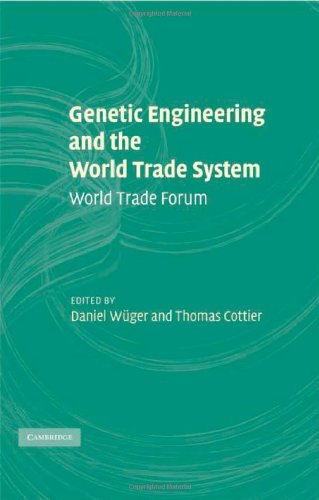Daniel Wüger, Thomas Cottier0521883601, 9780521883603, 9780511397226
Table of contents :
Half-title……Page 3
Title……Page 5
Copyright……Page 6
Contents……Page 7
Contributors……Page 9
Abbreviations……Page 11
PART I Introduction and systemic issues……Page 13
A Introduction……Page 15
1 Environmental sustainability of modern biotechnology……Page 17
2 Economic sustainability of modern biotechnology……Page 21
3 Social sustainability of modern biotechnology……Page 23
C Biotechnology in a multilayered regulatory environment……Page 26
A The focus on trade regulation……Page 29
B Underlying issues……Page 32
C Foundations……Page 35
1 Core human rights relating to genetic engineering……Page 36
2 Current WTO rules addressing genetic engineering……Page 37
3 The absence of explicit reference to human rights in trade regulation……Page 38
D The ambiguity of human rights in genetic engineering……Page 41
1 Principles of interpretation……Page 44
(a) GATT Agreements……Page 47
(b) The GATS……Page 49
(c) The TRIPS Agreement……Page 50
F Sketching elements of future trade regulations for biotechnology……Page 59
(a) Scientific risk assessment……Page 60
(d) The precautionary principle……Page 61
(g) Reference to morality?……Page 62
(a) Intellectual property……Page 63
(c) Liability rules……Page 64
4 Coherence……Page 65
G Conclusion……Page 66
A Introduction……Page 68
B Gendered aspects of biotechnology policy and trade……Page 70
1 Agriculture……Page 71
2 Traditional knowledge……Page 76
C Development of gender mainstreaming in international law and institutions……Page 78
D Conclusion: gender mainstreaming in biotechnology policy and trade……Page 85
PART II Intellectual property and gene technology: issues at stake and possible options……Page 87
A Introduction……Page 89
1 Microorganisms, plants and animals……Page 90
3 Ethics……Page 93
5 Traditional knowledge……Page 94
6 Health……Page 97
C European approachesthe European Patent Convention and the EU Biotechnology Directive……Page 98
1 The European Patent Convention……Page 99
(a) Biological material and recombinant proteins……Page 100
(b) Microorganisms, plants and animals……Page 101
(c) The human body, gene sequences and stem cells……Page 103
(d) Ethics……Page 106
(e) Safeguarding human rights……Page 108
(f) Traditional knowledge……Page 110
D National accents……Page 112
2 Human genes, gene sequences and stem cells……Page 113
3 Ethics……Page 114
5 Traditional knowledge……Page 115
6 Health……Page 117
2 Human genes and stem cells……Page 118
5 Traditional knowledge……Page 119
6 Health……Page 120
5 Intellectual property rights, biotechnology and development: African perspectives……Page 121
B The concept and nature of traditional knowledge……Page 130
C ‘Exogenous’ implications of patenting traditional knowledge……Page 135
D The significance of traditional knowledge and its protection under international law……Page 138
E Traditional knowledge and intellectual property rights: the current debate……Page 143
F Protection of traditional knowledge and intellectual property rights: what legal regime?……Page 146
G Content of an international regulatory framework……Page 153
H Conclusion……Page 159
PART III Food security, trade and agricultural production with genetically modified organisms……Page 161
B From plants to chemicals and back to plants……Page 163
C Biotechnology in the energy sector……Page 167
D The trade and development implications……Page 176
E Conclusions……Page 185
A Coexistence as a general problem……Page 187
B Lessons from the Schmeiser v. Monsanto case……Page 190
C Addressing the specific problems of GMO……Page 194
D The nature of national policies on GMOs……Page 199
E The impact of national policies on trade……Page 202
F Conclusion……Page 204
A What is at stake?……Page 205
1 Trade regime v. trade regime lite: a clash of cultures……Page 210
2 Towards a ‘framework capable of reasonably balancing and weighing different’ values……Page 212
3 Get antitrust to work……Page 213
PART IV Food safety, international trade and biotechnology……Page 215
A Introduction……Page 217
1 The scope of the Cartagena Protocol on Biosafety……Page 220
2 The relationship between the Cartagena Protocol and the WTO Agreements: the terms of the debate……Page 222
3 Which trade-restrictive measures could be defended under the Cartagena Protocol?……Page 223
1 The Doha Declaration and the treatment of the relationship between the WTO Agreements and MEAs……Page 224
2 International treaty practice related to the regulation of the relationship between MEAs and the WTO Agreements……Page 226
1 Scope and content of the ‘presumption against conflict’ in general public international law……Page 229
2 The notion of conflict under WTO case law……Page 232
E Transcending the logic of conflict: towards new paths and principles of ‘coexistence’ and ‘coherence’ between the WTO Agreements and MEAs……Page 233
(a) Significance of the principle……Page 234
(b) The right to determine the appropriate level of protection of the environment and public health is guaranteed by the application of the principle and embodied in WTO law
……Page 237
(c) The absence of hierarchy between MEAs and the WTO Agreements……Page 239
(a) Significance of the principle……Page 240
(b) ‘Institutional’ aspects of the principle of mutual supportiveness……Page 241
(c) ‘Regulatory’ aspects of the principle of mutual supportiveness: the issue of standardisation……Page 243
F Assessing the compatibility of biotechnology regulations with the WTO Agreements……Page 249
1 Regulations on GMOs and GATT 1994……Page 250
2 Regulations on GMOs and the SPS Agreement: about the acceptability of ‘precaution’ in international trade……Page 252
3 The ‘applicability’ of the Cartagena Protocol in a WTO dispute……Page 254
G Conclusion……Page 256
A Introduction and overview……Page 258
(a) Security, risk and risk regulation……Page 259
(b) Risk regulation of genetically modified organisms and the concept of substantial equivalence……Page 262
(a) Origins……Page 264
(b) Concept of precaution……Page 266
(c) Status of precaution in international law……Page 270
3 Trade……Page 272
(a) ‘Like products’……Page 275
(b) Process and production methods (PPMs)……Page 277
(c) General exceptions……Page 278
(a) Characteristics of the international environment and trade regimes……Page 279
(b) General relationship between the international environment and trade regimes……Page 282
(c) Conflicts between the international environment and trade regimes……Page 283
(d) The principles of no hierarchy, mutual supportiveness and deference……Page 287
1 The relationship between precaution and WTO law in general……Page 292
2 WTO law and precaution……Page 293
E Conclusions……Page 295
PART V Medical research, cloning and international trade……Page 297
A Introduction……Page 299
B Two conceptions of human dignity……Page 304
1 Human dignity as empowerment……Page 305
2 Human dignity as constraint……Page 306
3 The tension between the rival approaches……Page 308
4 Dignitarian exception and the case of cross-border gambling……Page 310
C A community of rights as an interpretive community……Page 312
D Connecting human dignity to human rights……Page 316
E Cosmopolitanism, convergence and divergence……Page 320
F Conclusion……Page 324
A Introduction……Page 327
B Prohibition of reproductive cloning and debate on therapeutic cloning……Page 332
C The symbolic junction between the concept of common heritage of humanity and the restriction of the lucrative exploitation of human genetics……Page 336
D Human genetic research and sharing of scientific information?……Page 340
E Balancing the prohibition of financial gain against the patentability of human genetics……Page 346
F Conclusions……Page 353
Index……Page 355







Reviews
There are no reviews yet.